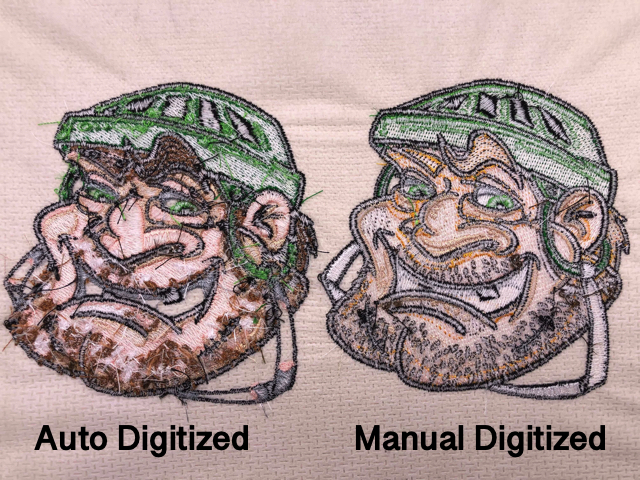Reliable Digitizing for Embroidery: Relied On by Specialists
Reliable Digitizing for Embroidery: Relied On by Specialists
Blog Article
Discover Different Sorts Of Embroidery Digitizing Methods
Embroidery digitizing has actually evolved substantially throughout the years, providing a myriad of strategies to bring layouts to life in the electronic realm. From the complex artistry of standard hand needlework digitizing to the precision of the boxing strategy, and the convenience of auto-digitizing software application, the options are huge. The world extends to much more sophisticated methods like photorealistic needlework digitizing and the interesting world of 3D needlework digitizing. Each strategy brings a distinct set of opportunities and obstacles to the table, making the expedition of these techniques an engaging trip for those in the needlework globe.
Conventional Hand Embroidery Digitizing
Traditional hand embroidery digitizing entails the procedure of converting detailed hand-stitched designs into digital layouts for equipment embroidery. This strategy needs competent artisans to thoroughly examine the handmade layout and after that make use of specialized software to recreate it in an electronic layout. Each stitch, shade, and detail must be carefully translated to ensure that the significance of the original hand needlework is protected in the digital version.
Among the crucial difficulties of conventional hand needlework digitizing is recording the details and nuances of the handmade design. Digitizing for Embroidery. Craftsmens need to possess a deep understanding of different needlework methods, such as satin stitch, chain stitch, and French knots, to accurately reproduce these methods in the digital realm. Furthermore, they need to have a keen eye for information to make certain that the digital design maintains the very same level of virtuosity and workmanship as the original hand-stitched item
Punching Technique
To seamlessly change from conventional hand needlework digitizing to the punching strategy, artisans should currently concentrate on converting the complex digital styles into directions that embroidery makers can interpret. The boxing method entails utilizing specialized software to produce digital data that include commands for the needlework machine to adhere to. This process calls for a deep understanding of not just the design itself however also the capacities and limitations of the needlework machine.

Auto-Digitizing Software Application Programs
Embroidery digitizing has been changed by the arrival of auto-digitizing software application programs, giving craftsmens with innovative devices to transform electronic layouts right into needlework equipment instructions efficiently. Auto-digitizing software program programs utilize formulas to assess electronic images or vector files and produce embroidery styles instantly. These programs enable quick and exact conversion of intricate designs into stitch patterns, saving effort and time for embroiderers.
One of the vital advantages of auto-digitizing software application is its easy to use interface, making it obtainable to both beginners and seasoned important link digitizers. These programs typically consist of functions such as stitch editing and enhancing devices, string shade matching, and the capability to preview the last stitched design. In addition, auto-digitizing software can take care of complicated designs with numerous shades and elaborate information, creating top notch embroidery data appropriate for various garments and fabric projects.
While auto-digitizing software program supplies benefit and efficiency, it is essential for customers to recognize the restrictions of automated digitizing. Fine-tuning and hands-on adjustments might still be needed to achieve the preferred embroidery top quality, especially when taking care of elaborate or one-of-a-kind layouts. By leveraging the abilities of auto-digitizing software application along with manual digitizing techniques, artisans can improve their needlework digitizing procedure and create spectacular stitched items.
Photorealistic Needlework Digitizing
Using advanced electronic imaging techniques, accomplishing photorealistic outcomes in embroidery digitizing has actually come to be an in-demand ability among contemporary artisans. This method entails converting high-resolution pictures right into intricate stitch patterns that carefully resemble the initial design, leading to needlework pieces that exhibit realistic detail and deepness.
To achieve photorealistic embroidery digitizing, artisans need to have an eager eye for detail and a thorough understanding of how different stitch types and densities can impact the last end result. By meticulously mapping out each color and shade in the image, embroiderers can produce a digital file that guides the embroidery equipment to reproduce the subtleties of the initial image accurately.
Photorealistic embroidery digitizing is particularly prominent in developing customized layouts for garments, home decor, and art pieces where capturing the essence of a photograph or artwork is critical. This strategy enables artisans to transform memories, landscapes, pictures, and intricate artwork right into stunning embroidered masterpieces that showcase a blend of conventional craftsmanship and innovative innovation.
3D Embroidery Digitizing
With the development of More Help electronic imaging techniques in achieving photorealistic results in needlework digitizing, the exploration of 'D Embroidery Digitizing' supplies a new dimension to the details of layout replication. 'D Embroidery Digitizing' describes the three-dimensional digitizing technique that includes deepness and texture to needlework layouts, producing a more practical and visually attractive last product. This method uses software application that imitates the result of light and shadow on the needlework layout, improving its total aesthetic influence.
Among the vital advantages of 'D Embroidery Digitizing' is its ability to make designs look more realistic and dynamic. By including depth my site to the embroidery layout, the final item appears much more realistic and exciting (Digitizing for Embroidery). Furthermore, this strategy enables for even more innovative flexibility in design implementation, enabling embroiderers to experiment with various textures and impacts that were formerly challenging to attain
Conclusion

Report this page